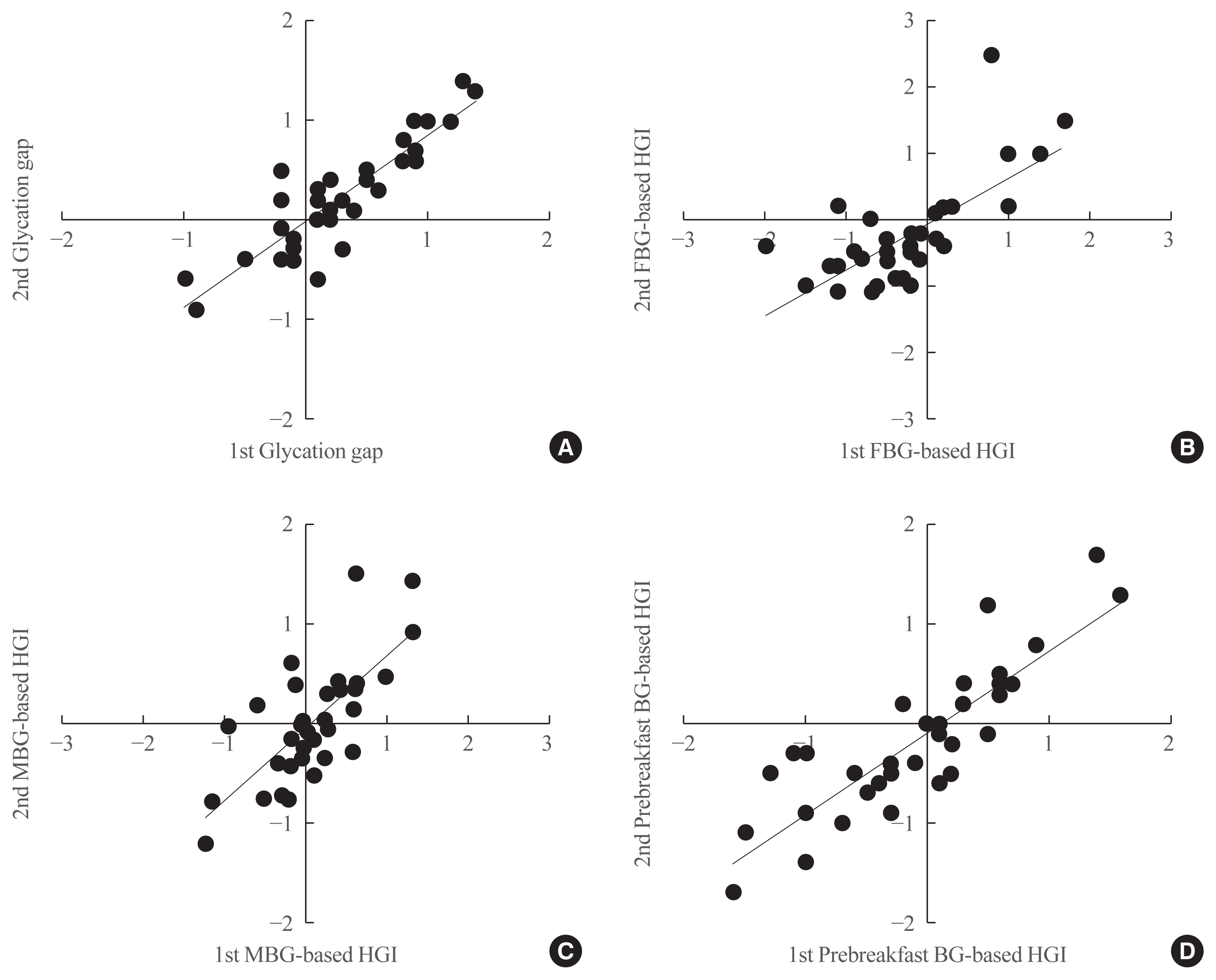Search
- Page Path
- HOME > Search
Original Article
- Clinical Study
- Consistency of the Glycation Gap with the Hemoglobin Glycation Index Derived from a Continuous Glucose Monitoring System
- Han Na Joung, Hyuk-Sang Kwon, Ki-Hyun Baek, Ki-Ho Song, Mee Kyoung Kim
- Endocrinol Metab. 2020;35(2):377-383. Published online June 24, 2020
- DOI: https://doi.org/10.3803/EnM.2020.35.2.377

- 5,869 View
- 113 Download
- 3 Web of Science
- 3 Crossref
-
 Abstract
Abstract
 PDF
PDF Supplementary Material
Supplementary Material PubReader
PubReader  ePub
ePub - Background
Discordances between glycated hemoglobin (HbA1c) levels and glycemic control are common in clinical practice. We aimed to investigate the consistency of the glycation gap with the hemoglobin glycation index (HGI).
Methods
From 2016 to 2019, 36 patients with type 2 diabetes were enrolled. HbA1c, glycated albumin (GA), and fasting blood glucose levels were simultaneously measured and 72-hour continuous glucose monitoring (CGM) was performed on the same day. Repeated tests were performed at baseline and 1 month later, without changing patients’ diabetes management. The HGI was calculated as the difference between the measured HbA1c and the predicted HbA1c that was derived from CGM. The glycation gap was calculated as the difference between the measured and GA-based predicted HbA1c levels.
Results
Strong correlations were found between the mean blood glucose (MBG)-based HGI and the prebreakfast glucose-based HGI (r=0.867, P<0.001) and between the glycation gap and the MBG-based HGI (r=0.810, P<0.001). A close correlation was found between the MBG-based HGI at baseline and that after 1 month (r=0.729, P<0.001), with a y-intercept of 0 and a positive slope.
Conclusion
The HGI and glycation gap were highly reproducible, and the magnitudes of repeated determinations were closely correlated. Patients with similar mean glucose levels may have significantly different HbA1c levels. -
Citations
Citations to this article as recorded by- Factors associated with hemoglobin glycation index in adults with type 1 diabetes mellitus: The FGM‐Japan study
Naoki Sakane, Yushi Hirota, Akane Yamamoto, Junnosuke Miura, Hiroko Takaike, Sari Hoshina, Masao Toyoda, Nobumichi Saito, Kiminori Hosoda, Masaki Matsubara, Atsuhito Tone, Satoshi Kawashima, Hideaki Sawaki, Tomokazu Matsuda, Masayuki Domichi, Akiko Suganu
Journal of Diabetes Investigation.2023; 14(4): 582. CrossRef - The Fast-Glycator Phenotype, Skin Advanced Glycation End Products, and Complication Burden Among People With Type 1 Diabetes
Alberto Maran, Mario Luca Morieri, Daniele Falaguasta, Angelo Avogaro, Gian Paolo Fadini
Diabetes Care.2022; 45(10): 2439. CrossRef - Hemoglobin glycation index, calculated from a single fasting glucose value, as a prediction tool for severe hypoglycemia and major adverse cardiovascular events in DEVOTE
Klara R Klein, Edward Franek, Steven Marso, Thomas R Pieber, Richard E Pratley, Amoolya Gowda, Kajsa Kvist, John B Buse
BMJ Open Diabetes Research & Care.2021; 9(2): e002339. CrossRef
- Factors associated with hemoglobin glycation index in adults with type 1 diabetes mellitus: The FGM‐Japan study


 KES
KES

 First
First Prev
Prev



